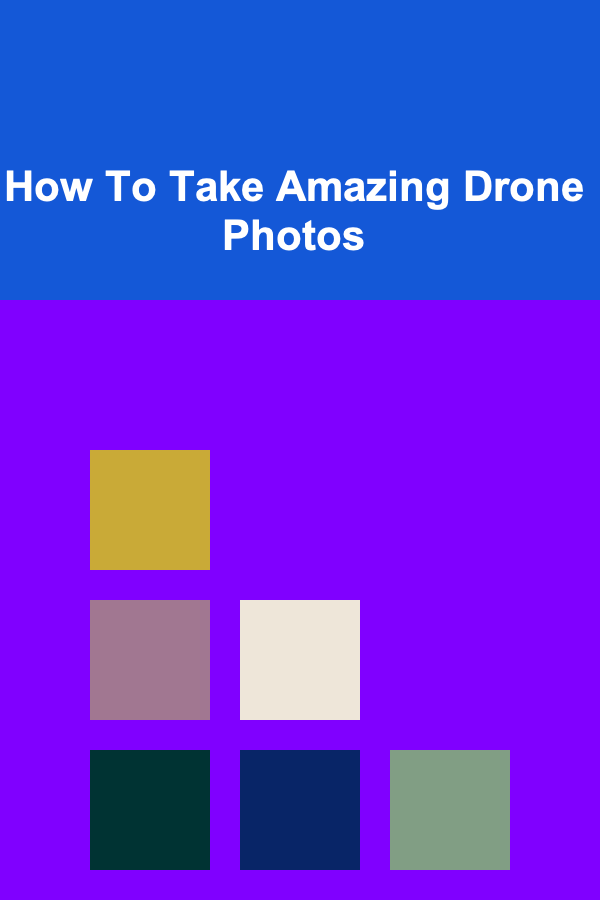
How To Take Amazing Drone Photos
ebook include PDF & Audio bundle (Micro Guide)
$12.99$11.99
Limited Time Offer! Order within the next:

In recent years, drones have revolutionized the way we capture photos, offering a unique perspective from the sky. Whether you're an amateur photographer or a seasoned professional, drones have made it easier than ever to take breathtaking aerial photographs. However, to truly take amazing drone photos, it's not just about flying a drone and pressing a button. It requires an understanding of composition, lighting, camera settings, and the environment. In this guide, we'll cover everything you need to know to take stunning drone photos, from the basics of drone photography to advanced techniques.
Understanding Your Drone and Its Capabilities
Before diving into the creative aspects of drone photography, it's essential to familiarize yourself with your drone's features and capabilities. Different drones have different camera specifications, flight capabilities, and features. Knowing your drone inside out will allow you to make the most out of its functions, ensuring that you capture the best images possible.
1.1 Camera Specifications
- Resolution: The higher the resolution, the more detail you can capture. Most drones today offer cameras with resolutions ranging from 12MP to 48MP or higher. If you plan to crop or enlarge your images, a higher resolution is essential.
- Lens Focal Length: The lens on your drone camera plays a significant role in how your photos look. A wider lens will allow you to capture expansive landscapes, while a telephoto lens is better for capturing distant subjects.
- Sensor Size: A larger sensor typically results in better image quality, especially in low-light conditions. Larger sensors capture more light, reducing noise and improving dynamic range.
- Aperture: Many drones offer adjustable aperture settings. A lower f-stop (e.g., f/2.8) allows more light into the sensor, making it ideal for low-light conditions. A higher f-stop (e.g., f/11) will result in more depth of field, keeping more of the scene in focus.
1.2 Understanding Flight Modes
Modern drones come with various flight modes that can help you capture smoother and more precise shots.
- GPS Mode: This mode uses satellite signals to keep the drone stable. It's perfect for capturing steady shots in calm weather.
- Sport Mode: In this mode, the drone responds quickly to your inputs and can be useful for fast-moving subjects. However, it can be harder to control, especially when trying to compose a shot.
- Follow Me Mode: This mode allows the drone to follow you or a subject automatically, keeping it centered in the frame. It's excellent for action shots and video footage.
- Orbit Mode: This mode lets the drone fly around a subject in a circular pattern, maintaining a consistent distance and angle. It's great for creating dynamic aerial shots of specific subjects.
- Waypoint Mode: This mode allows you to set a series of flight points for the drone, ensuring that it follows a specific path. It's perfect for capturing consistent shots from multiple angles.
1.3 The Importance of Battery Life
Drone photography often requires you to stay in the air for extended periods to capture the perfect shot. Ensure that your drone's battery life is sufficient for your intended flight. Most drones offer a flight time of 20 to 30 minutes, but this can vary depending on factors like weather conditions, the weight of the drone, and how hard you're pushing it.
Understanding Composition
Photography, in general, relies heavily on composition. The same goes for drone photography. While the aerial perspective offers unique opportunities, the principles of composition remain essential for creating visually stunning images.
2.1 Rule of Thirds
The rule of thirds is one of the most basic yet powerful compositional techniques in photography. Imagine dividing your frame into nine equal parts by two horizontal and two vertical lines. Placing key elements of your scene along these lines or at their intersections creates a balanced and engaging composition. In drone photography, this could mean positioning the horizon along the bottom or top third of the frame or placing a landmark at an intersection point to guide the viewer's eye.
2.2 Leading Lines
Leading lines are another crucial compositional element in drone photography. These are natural or man-made lines that lead the viewer's eye through the photo. Roads, rivers, and fences are all examples of leading lines that can add depth and visual interest to your shots. From an aerial perspective, you have a unique advantage in using these lines to create dynamic compositions that draw the viewer's attention to the main subject.
2.3 Symmetry and Reflections
Aerial photography offers an excellent opportunity to capture symmetry and reflections. Whether it's a symmetrical city grid or the reflection of mountains in a lake, these elements can make for incredibly striking images. By positioning your drone perfectly, you can highlight the natural or architectural symmetry of the scene.
2.4 Perspective
One of the unique advantages of drone photography is the ability to change your perspective. Unlike traditional photography, where you're confined to the ground, drones give you the ability to experiment with different angles, altitudes, and orientations. Experimenting with perspective can help create visually compelling images that might be impossible to capture from the ground.
Mastering Lighting
Lighting is a critical element in any form of photography, and drone photography is no exception. The way light interacts with your subject will influence the mood and quality of your images. Here are some tips for mastering lighting in drone photography.
3.1 The Golden Hour
The golden hour, which occurs shortly after sunrise and before sunset, offers the best lighting for photography. During this time, the sun is lower in the sky, creating softer and more flattering light. The warm tones of the golden hour also add a sense of warmth and depth to your photos. Planning your drone flights around this time can result in stunning, cinematic shots.
3.2 Avoiding Harsh Midday Sun
While the golden hour provides ideal lighting conditions, it's often not possible to time every flight to coincide with these moments. If you find yourself flying during midday when the sun is harsh and directly overhead, be mindful of shadows. Harsh sunlight can create strong shadows that may distract from the subject. If you must fly during this time, try to adjust your drone's angle or position to minimize the impact of harsh lighting.
3.3 Cloudy Days
Cloudy days can be great for drone photography, especially if you're shooting landscapes. The diffuse light from overcast skies reduces harsh shadows and creates a more even exposure throughout your shot. While you won't get the warm glow of the golden hour, cloudy skies can produce dramatic and moody photos, particularly when combined with scenic elements like mountains or lakes.
3.4 Utilizing Artificial Light
If you're shooting at night or in low-light conditions, you may need to rely on artificial light. While most drones are equipped with basic lights for visibility, they are generally not powerful enough to serve as the primary light source for a photo. Consider using additional lighting sources, such as streetlights, car headlights, or external lighting systems, to enhance your shots.
Choosing the Right Location
A successful drone photo often starts with the right location. Whether you're shooting urban landscapes, natural vistas, or something more abstract, your choice of location can significantly impact the final image.
4.1 Urban and Architectural Photography
Drones are excellent tools for capturing architectural shots, offering an elevated perspective that ground-level photographers can't achieve. Look for areas with unique architectural features, such as bridges, skyscrapers, or historic buildings. The interplay between light and shadow can create interesting contrasts in urban environments, and drones allow you to capture these elements from angles that would be impossible on foot.
4.2 Nature and Landscape Photography
Drones excel at capturing sweeping landscapes and natural scenes. Whether it's a lush forest, a winding river, or a vast desert, an aerial shot can reveal the true scale and beauty of a location. Look for dramatic natural formations, such as mountains, cliffs, and bodies of water, to create awe-inspiring images. Just be sure to respect local regulations regarding drone flight in natural areas, as certain regions may have restrictions to protect wildlife or the environment.
4.3 Water and Reflections
One of the most captivating subjects for drone photography is water. Whether it's an ocean, lake, or river, water can create stunning reflections that add depth and interest to your photos. When shooting over water, try to position your drone to capture both the subject and its reflection in the water's surface. Calm days with little wind are ideal for capturing smooth, mirror-like reflections.
Advanced Drone Photography Techniques
Once you've mastered the basics, it's time to take your drone photography to the next level with advanced techniques.
5.1 Long Exposure Photography
Some drones allow you to use long exposure settings, which can be used to capture motion blur in elements like clouds, water, or vehicles. By slowing down the shutter speed, you can create a sense of movement in your images, making them more dynamic and artistic. This technique works particularly well for capturing landscapes, cityscapes, and seascapes.
5.2 HDR Photography
High Dynamic Range (HDR) photography is a technique that involves capturing multiple images at different exposures and combining them to create a single image with greater detail in both the highlights and shadows. Many drones offer an HDR mode, which can be useful for situations where there are strong contrasts in lighting, such as shooting in bright sunlight or during sunset.
5.3 Panorama Shots
Most modern drones have a panorama mode, which allows you to capture wide, sweeping images. By automatically taking a series of photos and stitching them together, this mode can create stunning panoramic shots that showcase expansive landscapes. For the best results, choose a location with interesting lines, such as a coastal view or a mountain range, and make sure to fly the drone slowly to capture as much detail as possible.
5.4 Shooting in Raw Format
If you want to have maximum control over your photos during post-processing, consider shooting in RAW format. RAW files contain more image data than JPEGs, allowing you to make significant adjustments to exposure, color, and contrast without sacrificing image quality. This is especially useful when working with images that have complex lighting or need significant adjustments after the fact.
Post-Processing Your Drone Photos
While capturing great drone photos in-camera is essential, post-processing can take your images from good to extraordinary. Software like Adobe Lightroom, Photoshop, and Capture One can help you fine-tune your photos by adjusting elements such as exposure, contrast, and color balance.
6.1 Enhancing Colors
Drone photos often benefit from enhanced colors, especially if you're shooting landscapes or nature scenes. Adjusting the vibrance and saturation of the image can make the colors pop, giving the photo more life and vibrancy. Be cautious not to overdo it, though, as this can make the photo look unnatural.
6.2 Correcting Distortions
Some drones, particularly those with wide-angle lenses, may introduce distortion, especially around the edges of the frame. This can create a fisheye effect, which may not always be desirable. In post-processing, you can use lens correction tools to fix this distortion and straighten the lines in your photos.
6.3 Sharpening and Noise Reduction
Drones often shoot images at high ISO values, especially in low-light situations, which can introduce noise. In post-processing, use noise reduction tools to reduce the grainy look in your images. Additionally, sharpening tools can enhance details and make the photo appear crisper, particularly for elements like textures or distant objects.
Conclusion
Taking amazing drone photos requires a combination of technical skill, creativity, and an understanding of the environment. By familiarizing yourself with your drone's capabilities, mastering composition, understanding lighting, and using advanced techniques, you can capture breathtaking aerial shots that stand out. Whether you're shooting urban landscapes, natural wonders, or abstract reflections, the sky's the limit when it comes to drone photography. So, grab your drone, get out there, and start capturing the world from a whole new perspective.

How to Avoid Common Mistakes in Home Renovation Projects
Read More
How to Make a Checklist for Renovating Your Exterior
Read More
How to Optimize Your Website's Meta Tags for SEO Success
Read More
How to Store Holiday-Specific Items in Your Bathroom
Read More
How to Understand the Benefits of Fermented Foods
Read More
Incorporating Apitherapy: A Comprehensive Guide to Bee Products
Read MoreOther Products

How to Avoid Common Mistakes in Home Renovation Projects
Read More
How to Make a Checklist for Renovating Your Exterior
Read More
How to Optimize Your Website's Meta Tags for SEO Success
Read More
How to Store Holiday-Specific Items in Your Bathroom
Read More
How to Understand the Benefits of Fermented Foods
Read More